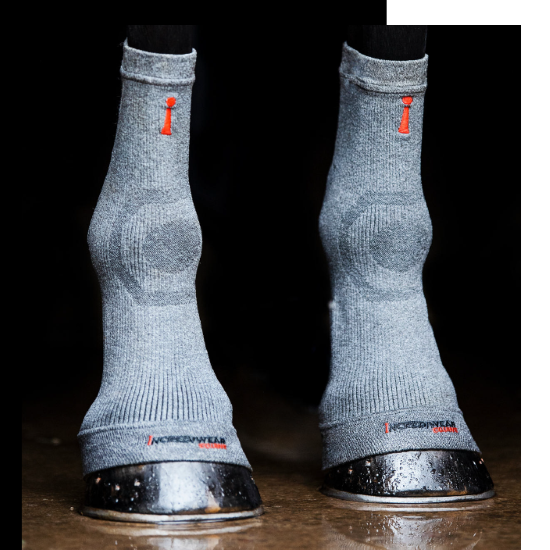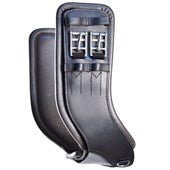Frequently Asked Questions about Pet Arthritis
Arthritis in pets is one of those double-edged swords; if we’re lucky, our pets will live long enough to develop it. Arthritis is extremely common in dogs, cats, and horses. In fact, 1 in 5 adult dogs has some degree of arthritis, and it’s found in approximately 65% of dogs older than 7 years. Cats don’t fare much better, with around 60% of cats over the age of 6 years showing arthritis in at least one joint. Cats older than 14 years have an 82% chance of developing it.
Horses are also at high risk for developing arthritis, whether they’re performance horses or family pets. Throughout their lifetimes, their joints never get a break – since horses stand so much, even at rest their joints bear their entire body weight on very small patches of cartilage. It’s believed that arthritis is responsible for up to 60% of all lameness cases in horses.
Types Of Arthritis In Pets
Arthritis is simply an inflammation of the joints. It can affect all kinds of pets in all stages of life, and it’s one of the most common health problems seen by veterinarians. Unfortunately, it’s also one of the most untreated, since many people don’t recognize the early warning signs of arthritis in their pets until the disease has progressed significantly.

Although most people are familiar with the degenerative form of arthritis seen in older animals and people, there are actually 3 different types of arthritis that can affect our pets:
- Osteoarthritis/Degenerative Joint Disease: This is the most common type of arthritis, frequently found in aging pets. It occurs when the cartilage lining of the joint wears down over time, causing pain, inflammation, and permanent damage to the joint.
- Septic arthritis: This is joint inflammation caused by a bacterial or fungal infection. This form is more commonly seen in dogs and horses, but very rare in cats.
- Immune-mediated polyarthritis: This type of arthritis occurs when an animal’s immune system begins to attack the body’s joints and destroy them, similar to rheumatoid arthritis in humans.
Causes Of Arthritis
Many diseases can affect the joints, and these can lead to the development of arthritis in pets. Joint diseases can occur as a result of:
- Trauma (such as bone fractures, tendon injuries, or stretched or torn ligaments)
- Conditions that cause an inflammatory response (Lyme disease, autoimmune disorders)
- Poor joint structure or development (hip Dysdplasia, elbow dysplasia, luxated patella, osteochondritis dissecans)
- Degenerative conditions, such as intervertebral disc disease of the spine or caudal equine syndrome.
- Cancer
- Excessive weight gain
Hormonal imbalances and certain metabolic diseases can also contribute to arthritis by causing a decrease in calcium, which weakens the bones.
Symptoms Of Arthritis In Pets
Unfortunately, the early signs of arthritis can be easy to miss. Especially when it comes to older pets, we tend to chalk up many of the clinical signs of arthritis as just a normal slowdown due to aging.
Warning signs of arthritis in pets may include:
- Limping that is most noticeable in the mornings, or when the pet gets up after sleeping; usually improves after the pet moves around for awhile.
- Unusual posture, commonly due to arthritis in the spine. This can include a hunched back or neck, or lameness in the hind legs.
- Stiffness, usually seen in dogs when they attempt to get in and out of the car or go up and down stairs. Cats may stop jumping onto beds, perches, or countertops due to pain and discomfort, and horses may have a noticeably stiff gait.
- Muscle atrophy, which occurs when muscles aren’t used as frequently. It appears as a visible thinning of the muscle in the area around the joint.
- Biting, licking, or chewing of the area around a sore joint. This can cause hair loss or skin inflammation.
- Irritability due to pain, especially when the pet is approached or handled.
- Reluctance to go on walks or play.
- Accidents in the house. This can occur due to not being able to get up quickly enough, or not being able to assume the correct position to eliminate (many arthritic cats have trouble climbing in and out of the litter box).
- Restlessness, or moving from place to place trying to find a comfortable position.
- Not getting along with other pets in the household. It’s tough on an arthritic pet when other pets are jumping around trying to play with them. A dog who growls or a cat who hisses at other pets may not have behavioral issues, they may simply be sore and in pain.
Oftentimes the pain from arthritis is noticeably worse after resting, during cold weather, or after vigorous exercise.
Diagnosing Arthritis
Veterinarians usually rely on a pet’s reaction to pain to help them diagnose arthritis. The exam includes joint palpation (where the veterinarian uses his or her hands to examine the pet’s range-of-motion, muscle mass, and joint sensitivity). He or she also checks for swelling in the joints, as well as for crepitus, which is a crackling or grating sensation in the joint that’s indicative of joint inflammation. The pet’s gait is also observed for stiffness or abnormal motion.
Radiographs, or x-rays, are very useful in helping to diagnose arthritis, as they can show any abnormal changes in the joint. Abnormalities include a narrowing of joint spaces, changes in the joint’s bone and/or cartilage, a thickening of soft tissue, fluid build-up around the joint, or the presence of osteophytes (“bone spurs”), which are bony outgrowths within the joint – all of which are associated with arthritis.
Treatment Options For Arthritis In Pets
Unfortunately, arthritis cannot be cured, and it tends to slowly worsen over time. But the good news is that arthritis pain can be successfully controlled by managing the inflammation within the joints. This can be accomplished by using a combination of several different methods, including anti-inflammatory medications, joint supplements, alternative therapies, and proper diet and exercise.
Below is a list of several different techniques that are currently available for managing arthritis in pets.
Prescription Medications
These can be a lifesaver for arthritic pets. There are several different types of prescription medications available; the most common ones are listed below.

NSAIDS: These are non-steroidal anti-inflammatories, and they are very effective at controlling pain and inflammation. The most popular options are currently Rimadyl, Deramaxx, Previcox, Metacam, Zubrin, Feldene, and EtoGesic. Ibuprofen and aspirin may also be used (in dogs only, NEVER in cats).
Although they are quite effective, NSAIDS should be used with great caution. They can cause gastric ulcers, bleeding disorders, and liver and kidney problems. Never give your pet any over-the-counter NSAIDs unless instructed by your veterinarian, and always follow your veterinarian’s NSAID dosing instructions to the letter.
Pain medications: Prescription pain medications such as tramadol, gabapentin, and amantadine target the nervous system and alter the transmission and strength of pain signals in the brain. These drugs are very well-tolerated by dogs, cats, and horses.
Corticosteroids: These include prednisone and dexamethasone, and they have been used for years to quickly and effectively reduce pain and inflammation associated with joint disease. However, their use is controversial because they also come with a very long list of side effects. When used long-term, corticosteroids can cause Cushing’s disease and liver inflammation, contribute to the development of diabetes, and drastically suppress the immune system.
Because of these side effects, and with newer, safer drugs now available, corticosteroids are now generally only used in older pets with severe arthritis who don’t respond to other medications.
Adequan: This drug is considered the gold standard for treating arthritis in dogs, cats, and horses. It not only prevents the breakdown of cartilage, it’s been proven to help the body repair itself by assisting with the creation of new cartilage. Extremely safe and largely without side effects, Adequan is given as a series of injections over several weeks. Although it can be more expensive than other prescription medications, the success rate for pets receiving Adequan is impressive.
Hyaluronic Acid (Legend): This medication for horses (which is injected directly into the joint) contains hyaluronic acid, a component of joint fluid that helps protect the joint by increasing the viscosity of joint fluid and reducing inflammation and free radicals. Although currently only approved for horses, it may also be effective in dogs.
Pentosan polysulphate (Cartrophen or Zydax): This product is used in dogs, cats, and horses to increase both joint fluid production and blood supply to the joint. Pentosan polysulphate has also been proven to slow the progression of arthritis and help control pain.
Nutraceuticals/Dietary Supplements
“Nutraceuticals” is a term used for any product derived from food sources with extra health benefits in addition to the basic nutritional value found in the food itself. These substances are considered to be safer than traditional drugs and most have little to no side effects, but it may take several weeks before noticeable improvement is apparent.
Nutraceuticals come in various forms, from liquids to pills, and most are available over the counter. However, since these fall under the term “dietary supplements”, they are not regulated by the FDA, and quality can vary greatly depending on the manufacturer.
Glucosamine and Chondrotin: These are by far the most commonly used nutraceuticals in veterinary medicine. They give cartilage-forming cells (called chondrocytes) the building blocks they need to synthesize new cartilage and repair existing cartilage. These products are most effective when used together.
Glucosamine and chondroitin usually need to be given for at least 6 weeks before improvement is seen, and most pets need to be maintained on these products for the rest of their lives to prevent further cartilage breakdown. However, they are considered to be very safe and have few, if any, side effects.
Perna (Green-lipped) Mussels: These are edible shellfish found off the coast of New Zealand. They contain both glucosamine and chondroitin, as well as other nutrients thought to be beneficial to cartilage.
Duralactin: This is a patented ingredient obtained from the milk of grass-fed cows. It has anti-inflammatory properties, and is used along with NSAIDs or corticosteroids for the management of musculoskeletal problems in dogs.
Methyl-sulfonyl-methane (MSM): MSM is a sulfur-containing compound produced by ocean kelp. It’s reported to help reduce scar tissue, enhance the strength of connective tissue, and have anti-inflammatory and pain reducing properties.
Creatine: This is an amino acid derivative formed in the kidneys, liver, and pancreas. Although creatine does not build muscle, it assists the body with production of ATP, a fuel used by cells. Creatine may be beneficial for dogs with muscle atrophy associated with arthritis.
Advanced Cell Therapy
AdiCell and Cryo-shot are relatively new therapies that consist of the insertion of fatty tissue derived from a pet’s own stem cells directly into arthritic joints. This procedure is done under anesthetic, and has been shown to have a good anti-inflammatory effect.
Acupuncture
Although still considered a mystical form of alternative medicine by many, Acupuncture has been shown to increase endorphin release and reduce pain in arthritic pets. This often reduces the need for prescription medications, which can be extremely beneficial for pets who are unable to take NSAIDS due to underlying medical conditions. Acupuncture is most effective for the treatment of arthritis when combined with other treatments, as it seems to boost the positive effects of those treatments.
Laser Therapy
Often called cold laser, low-level laser, or Class IV laser therapy, this relatively new treatment uses a laser to treat arthritis in dogs, cats, and horses. Laser therapy stimulates blood flow to tissues and increases ATP, the “fuel” that cells use to repair themselves. Most patients require about 4 treatments before seeing an improvement in mobility and reduction in pain.
Diet and Weight Management
Extra weight makes the pain and inflammation of arthritis much worse by placing added stress on joints and ligaments. Arthritic pets who are at a healthy weight need less medication and have less pain than their overweight counterparts.
Diets rich in Omega-3 fatty acids have also been shown to block inflammation around joints, and to slow the progression of arthritis by suppressing enzymes that cause cartilage damage.
Therapeutic Exercise
Short bouts of regular exercise are extremely beneficial for pets with arthritis. Exercise that allows good range of motion and muscle building while limiting wear and tear on the joints is best. Walking on a leash, walking on an underwater treadmill, and swimming are all excellent low-impact exercises. Your veterinarian can help you develop a customized exercise program for your pet based on their weight, physical condition, and their severity of arthritis.
Home Therapies
There are also things you can do at home to make your arthritic pet more comfortable.
Customize your home: Provide your pet with carpeted steps or ramps to assist them in getting in and out of the car and on and off furniture. Wherever surfaces are slippery, use nonskid flooring. Thick, firm, orthopedic beds that are kept away from cold drafts help prevent painful pressure-point callouses and keep pets comfortable, and in the winter, sweaters and heated beds provide warmth that is soothing to arthritic joints. Large dogs may benefit from having their food and water bowls elevated which takes pressure off the neck and spine.
Physical Therapy and Massage: Arthritic pets respond extremely well to physical therapy and massage, which stimulates blood flow to atrophying muscles. Your veterinarian or your pet’s physical therapist can also show you how to perform massage on your pet at home.
Getting A Grip On Arthritis
Arthritis can develop in any pet at any time. Fortunately, there are many options available to treat arthritis in pets, and the most successful treatments use a combination of several different techniques that are customized to each individual pet.
Although arthritis cannot be cured, with the guidance of your veterinarian, it can be successfully managed. If you suspect your pet may be suffering from joint pain or stiffness, talk with your veterinarian about the best arthritis management program for your pet. Not only will your pet thank you, but the added benefit of treating arthritis in its early stages is that treatment can actually help slow the progression of the disease.

Equine..Human..Pet Essentials
Back on Track
Shop Back on Track for the best selection in restorative wear available for every athlete

#Live Incredibly
Incredi Wear Equine and Human
A key component of Performance is Recovery. IncrediWear products speed recovery while being extremely comfortable to wear and easy to care for.

Anatomic and Effective Fit
Total Saddle Fit
Design with Intention, Everything we sell is designed with the deliberate intention of shaping to a horse's body for improved comfort and performance.
